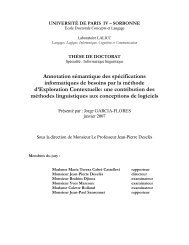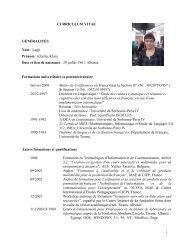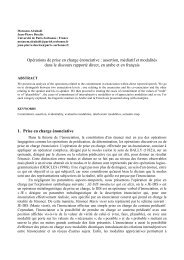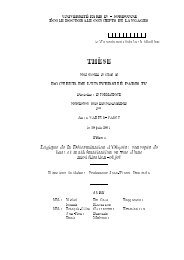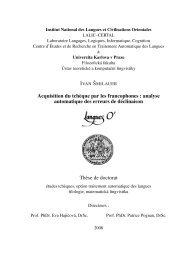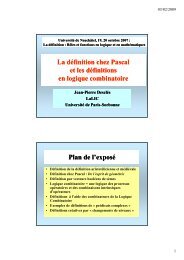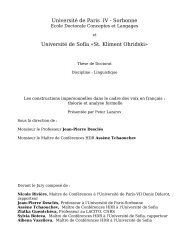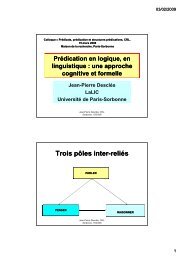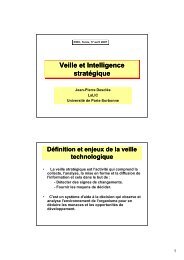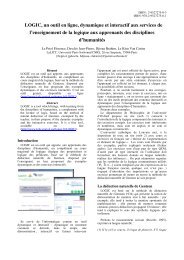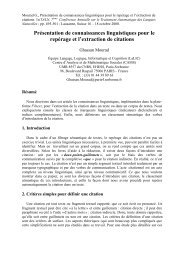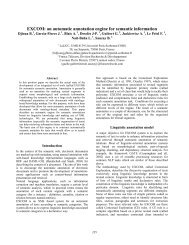Le résumé automatique de textes - LaLIC - Université Paris-Sorbonne
Le résumé automatique de textes - LaLIC - Université Paris-Sorbonne
Le résumé automatique de textes - LaLIC - Université Paris-Sorbonne
Create successful ePaper yourself
Turn your PDF publications into a flip-book with our unique Google optimized e-Paper software.
Sommaire<br />
6<br />
2.2.1. La métho<strong>de</strong> d’exploration contextuelle ..................................................................... 107<br />
2.2.2. La segmentation <strong>de</strong> <strong>textes</strong>.......................................................................................... 113<br />
2.2.3. Ecriture <strong>de</strong>s ressources linguistiques........................................................................ 115<br />
2.2.4. L’annotation <strong>automatique</strong> ......................................................................................... 120<br />
2.3. REMARQUES À PROPOS D’EXCOM.................................................................................... 122<br />
3. L’ANNOTATION DISCURSIVE AUTOMATIQUE DE TEXTES.............................................. 124<br />
3.1. STRUCTURATION DISCURSIVE DES TEXTES......................................................................... 124<br />
3.2. NATURE DES MARQUES DISCURSIVES................................................................................. 127<br />
3.3. CATÉGORIES DISCURSIVES ET RÈGLES D’EXPLORATION CONTEXTUELLE ........................... 136<br />
3.3.1. Remarques préalables ............................................................................................... 136<br />
3.3.2. <strong>Le</strong>s présentations thématiques................................................................................... 137<br />
3.3.3. <strong>Le</strong>s objectifs............................................................................................................... 143<br />
3.3.4. <strong>Le</strong>s problématiques ................................................................................................... 150<br />
3.3.5. <strong>Le</strong>s hypothèses........................................................................................................... 157<br />
3.3.6. <strong>Le</strong>s métho<strong>de</strong>s ............................................................................................................. 163<br />
3.3.7. <strong>Le</strong>s <strong>de</strong>scriptions techniques....................................................................................... 170<br />
3.3.8. <strong>Le</strong>s conclusions ......................................................................................................... 177<br />
3.3.9. <strong>Le</strong>s récapitulations .................................................................................................... 184<br />
3.3.10. <strong>Le</strong>s opinions ............................................................................................................ 192<br />
3.3.11. <strong>Le</strong>s soulignements ................................................................................................... 198<br />
3.3.12. <strong>Le</strong>s résultats ............................................................................................................ 205<br />
3.3.13. <strong>Le</strong>s évaluations........................................................................................................ 212<br />
3.3.14. <strong>Le</strong>s conséquences .................................................................................................... 218<br />
3.3.15. <strong>Le</strong>s rappels .............................................................................................................. 225<br />
3.3.16. <strong>Le</strong>s reformulations................................................................................................... 230<br />
3.4. SYNTHÈSE : LA CARTE SÉMANTIQUE .................................................................................. 237<br />
4. RÉALISATIONS INFORMATIQUES ............................................................................................ 240<br />
4.1. QUELQUES DONNÉES SUR LES RÉALISATIONS INFORMATIQUES .......................................... 240<br />
4.2. PRÉSENTATION DE L’INTERFACE DE VISUALISATION.......................................................... 241<br />
5. EVALUATION DE L’ANNOTATION DISCURSIVE .................................................................. 245<br />
5.1. OBJECTIF DE L’ÉVALUATION.............................................................................................. 245<br />
5.2. RÉSULTATS ........................................................................................................................ 248<br />
CHAPITRE 4 : PROCESSUS ET STRATÉGIES DE RÉSUMÉ AUTOMATIQUE...................... 255<br />
1. CONCEPTION GÉNÉRALE DU PROCESSUS ............................................................................ 256<br />
1.1. LE PROCESSUS RÉSUMANT ................................................................................................. 257<br />
1.1.1. Description générale................................................................................................. 257<br />
1.1.2. Description par étape................................................................................................ 259<br />
1.2. APPLICATION DE LA STRATÉGIE RÉSUMANTE..................................................................... 261<br />
1.2.1. Critères <strong>de</strong> pertinences adoptés ................................................................................ 261<br />
1.2.1.1. L’annotation discursive.....................................................................................................262<br />
1.2.1.2. La position textuelle..........................................................................................................264<br />
1.2.1.3. <strong>Le</strong>s termes thématiques .....................................................................................................266<br />
1.2.2. Présentation <strong>de</strong> <strong>de</strong>ux stratégies................................................................................. 268<br />
1.2.2.1. Une stratégie pour le <strong>résumé</strong> indicatif...............................................................................268<br />
1.2.2.2. Une stratégie pour le <strong>résumé</strong> <strong>de</strong> résultats ..........................................................................273



